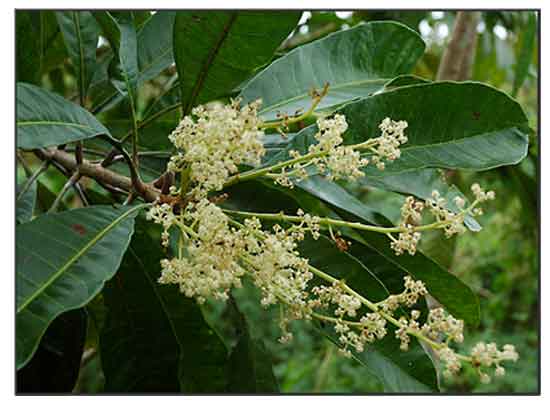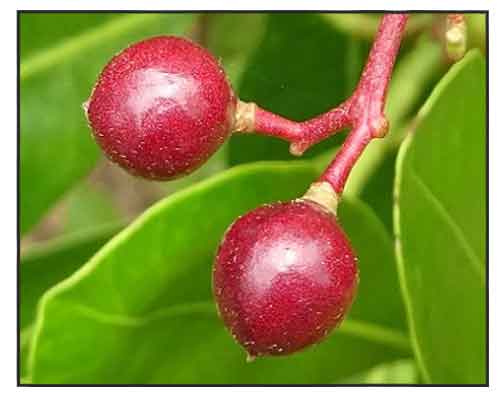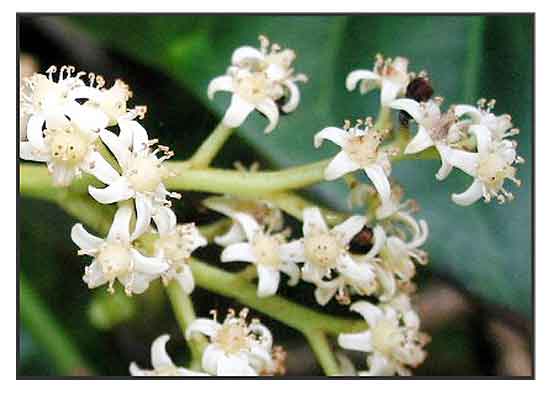
Family • Anacardiaceae
Balinghasay
Buchanania arborescens (Blume) Blume
LITTLE GOOSEBERRY TREE
Shan xian zi
| Scientific names | Common names |
| Buchanania angustifolia Benth. | Balinghasay (Tag.) |
| Buchanania arborescens (Blume) Blume | Balinghasai (Tag.) |
| Buchanania arborescens F.Muell. | Green plum (Engl.) |
| Buchanania arborescens var. obovata Blume | Jam Jam (Engl._ |
| Buchanania attopeunensis (Pierre) Tardieu | Little gooseberry tree (Engl.) |
| Buchanania bancana Miq. | Satinwood tree (Engl.) |
| Buchanania decandra Blanco | Sparrow's mango (Engl.) |
| Buchanania florida A.Gray | |
| Buchanania florida var. arborescens Engl. | |
| Buchanania florida var. attopeunensis Pierre | |
| Buchanania florida var. cumingii Engl. | |
| Buchanania florida var. dongnaiensis Pierre | |
| Buchanania florida var. lucida (Blume) Engl. | |
| Buchanania florida var. petiolaris (Miq.) Engl. | |
| Buchanania glaberrima Ridl. | |
| Buchanania intermedia Wight | |
| Buchanania longifolia Blume | |
| Buchanania longifolia Span. | |
| Buchanania lucida Blume | |
| Buchanania lucida var. laxiflora Ridl. | |
| Buchanania lucida var. palembanica (Blume) Miq. | |
| Buchanania monticola Kaneh. & Hatus. | |
| Buchanania muelleri Engl. | |
| Buchanania nabirensis Kaneh. & Hatus. | |
| Buchanania novohibernica Lauterb. | |
| Buchanania palembanica Blume | |
| Buchanania papuana C.T.White | |
| Buchanania petiolaris Miq. | |
| Buchanania platyphylla Merr. | |
| Buchanania polybotrya Miq. | |
| Buchanania pseudoflorida G.Perkins | |
| Buchanania scandens Lauterb. | |
| Buchanania solomonensis Merr. & L.M.Perry | |
| Buchanania subobovata Griff. | |
| Buchanania versteeghii Merr. & L.M.Perry | |
| Coniogeton arborescens Blume | |
| Lauro-cerasus laurifolia (Decne.) M.Roem. | |
| Prunus laurifolia Decne. | |
| Buchanania arborescens is an accepted species. It has 37 synonyms. KEW: Plants of the World Online | |
| Other vernacular names |
| BRUNEI: Kepala tundang, Rengas ayam. |
| CHINA: Shan xian zi. |
| INDONESIA: Popohan, Getasan, Rawa-rawa pipit. |
| MALAYSIA: Otak udang tumpul, Rengas laut, Beluno-beluno. |
| THAILAND: Chaa muang, Luaet khwai, Mamuang khee kratai. |
| VIETNAM: Cay mung ri. |
Botany
Constituents Properties Availability |
May 2023
![]()
 |
| PHOTOS / ILLUSTRATIONS |
| IMAGE SOURCE: Buchanania arborescens flowering twig / Copyright © 2011 by Leonardo L Co (contact: [email protected]) [ref. DOL80809] / Non-Commercial Use / click on image to go to source page / Phytoimages.siu.edu |
| OTHER IMAGE SOURCE: Photo: Balinghasay flowers / © Fruitipedia / Non-commercial use / click on image to go to source page / Fruitipedia |
| OTHER IMAGE SOURCE: Photo: Ripe fruits of balinghasay / © Fruitipedia / Non-commercial use / click on image to go to source page / Fruitipedia |
Additional
Sources and Suggested Readings |
• |
DOI: It is not uncommon for links on studies/sources to change. Copying and pasting the information on the search window or using the DOI (if available) will often redirect to the new link page. (Citing and Using a (DOI) Digital Object Identifier) |
| List of Understudied Philippine Medicinal Plants |
• |
 |




